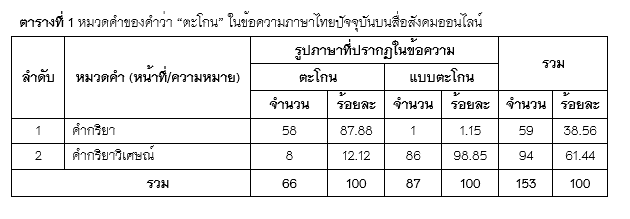/ta - koːn/ in Contemporary Thai: A Study of Function and Meaning
Main Article Content
Abstract
The Thai language is an isolating language that allows many words to have more functions or meanings according to the development of language use in each period. Thailand nowadays is an open communication society. Language users can freely choose words to communicate. That influenced many Thai vocabularies to change their original functions and meanings to new functions and meanings. The functions and meanings of the word /ta-koːn/ in Thai, a popular vocabulary among language users, have changed the overlap between old and new.
This qualitative research article aims to analyze the function and meaning of the word /ta - koːn/ that appears in Contemporary Thai. The data collected appears as the word /ta - koːn/ in current Thai text on social media between 1/1/2022 and 1/3/2023. By using a search engine https://www.google.co.th. The total of data collected that appears in the word /ta - koːn/ in current Thai text on social media is 153 texts and were classified according to the language that appeared into two forms: 66 texts containing the word /ta - koːn/ and 87 texts containing the word /bɛːb - ta - koːn/. The results revealed that the word /ta - koːn/ is classified into two-word classes: 1) a verb has a function to express action or the symptom of the doer, totaling 59 texts 2) an adverb has a function to serve as a modifier for the main verb in sentences, totaling 94 texts. The results of the research in terms of the meaning of the word /ta - koːn/ classified into two meanings: 1) the original meaning, which is the lexical meaning, that is 'utter louder than usual to be heard' and 2) The new meaning is an extension but still close to the original meaning, that is ‘expanding details or convey characteristics or consciousness of something in greater quantities than normal to show the image clearly or emphasize more special of something'.
Downloads
Article Details

This work is licensed under a Creative Commons Attribution-NonCommercial-NoDerivatives 4.0 International License.
The articles published are copyrighted by the Graduate School, Chiang Mai Rajabhat University.
The opinions expressed in each article of this academic journal are solely those of the individual authors and do not reflect the views of Chiang Mai Rajabhat University or its faculty members. The responsibility for the content of each article rests entirely with the respective authors. In the event of any errors, the authors alone are responsible for their own articles.
References
Bumroongsook, P. (1972). Polyfunctional words in the Thai language. (Master’s thesis, Department of Thai, Graduate School, Chulalongkorn University). [In Thai]
Jaratjarungkiat, S. (2015). Study of research methodology in the development of polysemes in Thai. Vannavidas, 15, 135-156. [In Thai]
Jaratjarungkiat, S. (2017). Grammaticalization of /jaŋ/. Journal of language and Linguistics, 35(2), 97 - 120. [In Thai]
Jinlert, N. (2016). Classification of words in Thai grammar: Various approaches and Theories. Vannavidas, 6, 189 - 216. [In Thai]
Meesat, P. (1997). A study of auxiliary verbs developed from verbs in Thai. (Master’s thesis, Department of Thai, Graduate School, Chulalongkorn University). [In Thai]
Motive Influence. (2022). A collection of the 20 most popular social media words of 2022, along with their origins and meanings. Retrieved from https://www.motiveinfluence.com/blog/marketing/ [In Thai]
Muangkaew, N. and Pothipath, V. (2013). The verb /kàrúnaa/ and the quantitative adverb /nɔ̀y/: The original sources of requestive markers in Thai. Vannavidas, 13, 95 - 114. [In Thai]
Nanthakanok, K. and Sukwat, B. (2019). A study in functions of the word /Khɔ̂j/ in Thai. MangRai Saan Journal, 7(1), 1 - 12. [In Thai]
Ongwuttiwat, S. (2008). “Ti” /thii/: A polyseme in contemporary Thai. Vannavidas, 8, 160 - 184. [In Thai]
Panupong, V. (2000). The structure of Thai: Grammatical system. Bangkok: Ramkhamhaeng University. [In Thai]
Phanthumetha, N. (2015). Thai grammar. (7th ed.). Bangkok: Faculty of Arts, Chulalongkorn University. [In Thai]
Phonkhunsap, S. and Dolphen, I. (2020). Grammaticalization of /hØ:t1/ in Northeastern Thai dialect. Language and Linguistics, 38(2), 1-37. [In Thai]
Rattanaphanusorn, R. (2006). Semantic extension of visual perception verbs in Thai. (Doctor of Philosophy’s thesis, Department of Linguistics, Graduate School, Chulalongkorn University). [In Thai]
Royal Institute. (2011). The royal institute dictionary 2011. Retrieved from https://dictionary.orst.go.th/ [In Thai]
Singnoi Wongwattana, U. (2012). Verbs in series in Thai: Serial verbs or others?. The Journal of Language and Culture (JLC), 31(2), 35 – 66. [In Thai]
Sompheth, S. (2020). The Semantic Extension of /kàt/ in Thai: A cognitive semantic study. Thai Language and Literature, 37(2), 1 - 36. [In Thai]
TNN Online. (2022). "Celebrities" shout out to "P'Jack" loudly at Rajamang! Mouth agape, stunned by his handsomeness. Retrieved from https://www.tnnthailand.com/news/trueinside/119128/ [In Thai]
Wareeket, K. and Pothipath, V. (2013). Grammaticalization of the noun /phǒm/. Vannavidas, 13, 1 - 17. [In Thai]
Wisesight. (2022). A collection of social media slang in 2022. Retrieved from https://wisesight.com/news/social-media-slang-2022/ [In Thai]


